The land of a thousands smiles, home of the Ark of the Covenant, custodian of some of the worlds oldest civilizations – this is Ethiopia. But how much do you really know about this amazing country? Let us fill the gaps.
Places and Travel in Ethiopia
Table of Contents
Legend has it that Emperor Menelik 1, was the son of the Queen of Sheba and King Solomon. It is said that Menelik brought the Ark of the Covenant from Jerusalem to Axum, where he settled and established one of the world’s longest known, uninterrupted monarchical dynasties.
This is only one example of Ethiopia’s magnificent history, which encompasses legend and tradition, mystery and facts, from a powerful and religious ancient civilization. The well-trodden path through Ethiopia’s famous and fascinating historic sites takes you through a scenic, magnificent world of fairy-tale names, such as Axum, Lalibela, Gondar, Debre Damo and Bahar Dar.
Travelling the route by plane, car or both will offer you a glimpse into a truly remarkable past. As well as many price less historical relics, you will also see the castles at Gondar, the churches of Lalibela hewn out of living rock, the mysterious giant stelae at Axum, the ruins of the Queen of Sheba’s palace, and the monastery at Debre Damo, whose access is limited to men and then only by way of a rope lowered by the friendly monks above.
Debre Markos
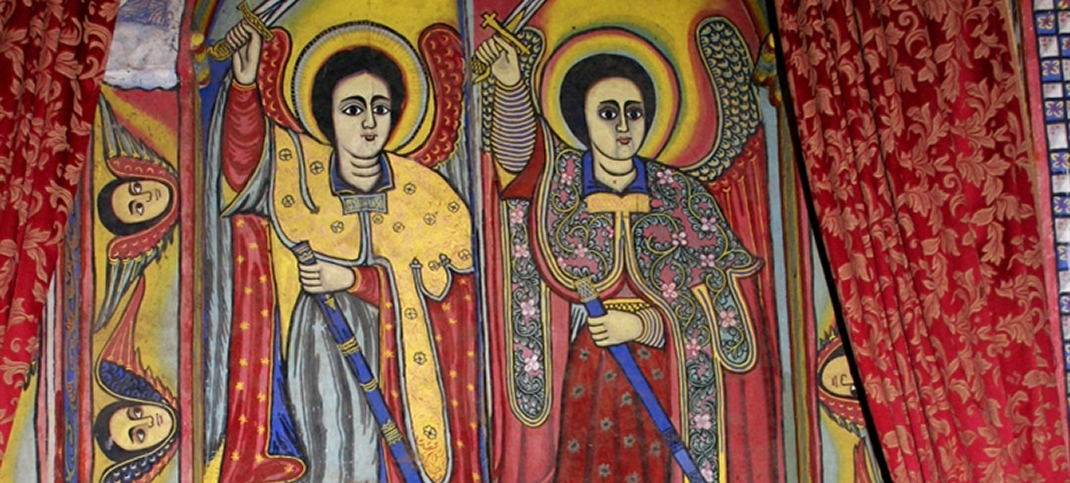
Taking the historic route north from Addis Ababa, the first stop is Debre Marko’s, 305 kilometer north of the capital. Here you will find the 19th century church of Markos (saint Markos), with its pale but beautiful paintings depicting scenes of biblical and religious history.
Bahar Dar
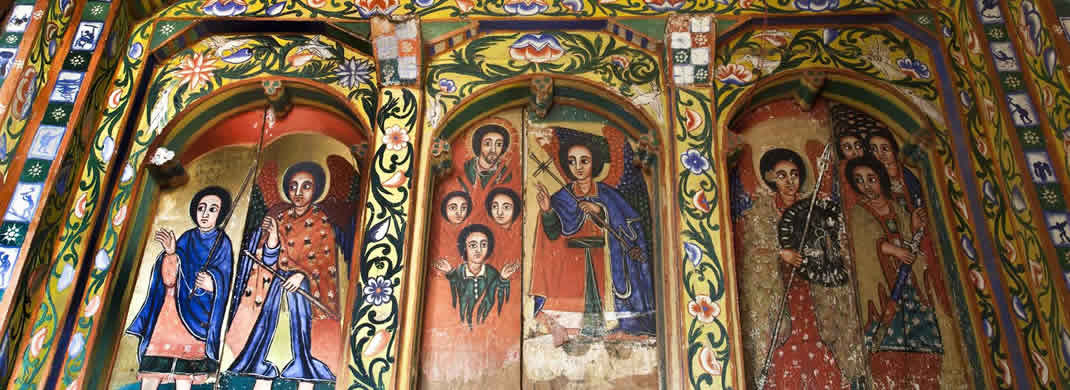
Bahar Dar, the next stop, is 578 kilometers from Addis Ababa. It is located on the southern shore of Lake Tana, the source of the Blue Nile. Its feature ancient island monasteries as well as the Tis Isat falls which is the most spectacular feature of both the Blue and the White Nile.
On the island of Dega Estefanos you will find the church of saint Stefano’s, which has a priceless collection of icons and manuscripts and houses the mummified remains of a number of Ethiopia emperors.
For the modern traveler, the starting point of any visit to the Blue Nile falls, or to the island of Lake Tana, is the bustling market town of Bahar Dar on the lake’s south-eastern shore. The colorful market and a variety of handicrafts and weaving centers also make it a comfortable base for excursion by land or water.
Bahar Dar port provides access by boat to a number of historic lakeside churches and monasteries near and far. Most date from the 17th-century and a beautifully painted wall. Many such places of worship now have fascinating museums, at which the visitors can see priceless illustrated manuscripts, historic crowns and fine, royal and ecclesiastical robes. Some monastic islands are forbidden to women, but others can be visited by all.
Visitors to Bahar Dar can also see Tankwas, locally made canoes made out of the papyrus reeds growing by the lake shore, as well as an historic old building erected, in St.Georges church compound, by the 17th –century Spanish Jesuit, Pero Paes.
Gondar
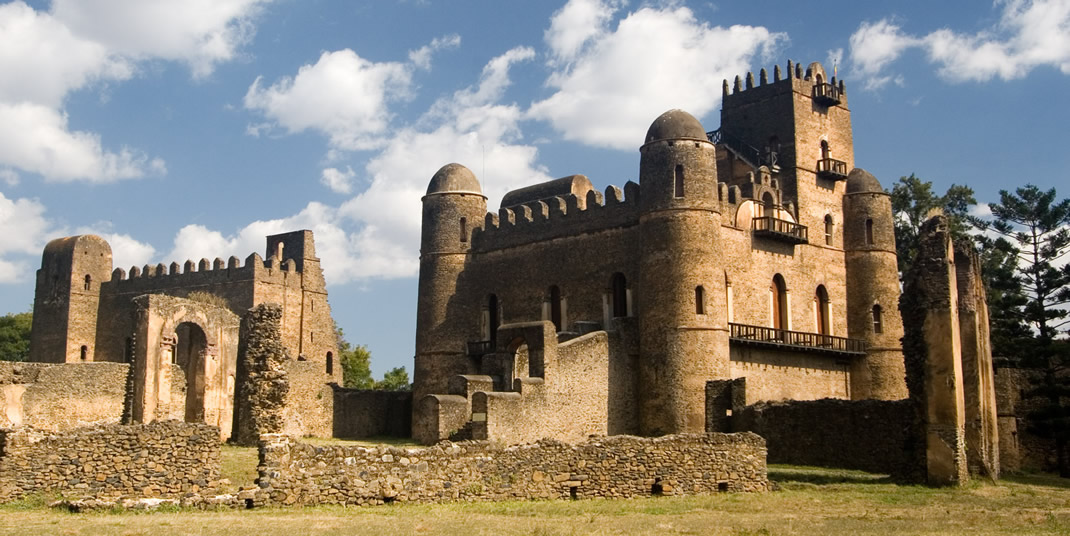
The next stop in the historic route is the graceful city of Gondar, founded by Emperor Fasilidas in 1636. The city was Ethiopia’s capital until the reign of the would-be reforming emperor Tewodros 11, also known as Theodore. During its long year as a capital, the settlement emerged as one of the largest and most populous cities in the realm. It was a greed commercial centre, trading with the rich lands south of the Blue Nile, as well as with Sudan to the west and the Red Sea port of Massawa to the north-east
Gondar is famous for its many medieval castle and the design and decoration of its churches. The earliest of the castle was created by Fasilidas himself and is still in such an excellent state of repair that it is possible to climb its stairs all the way up to the roof, which command a breathtaking view over much of the city. Beside the famous palaces, visitors should inspect the Bathing palace of emperor Fasilidas, which is used for the annual Timket or Epiphany celebrations, and the Abbey of the redoubtable 18th –century Empress Mentewab at Qwesquam, in the mountains just outside Gondar.
Yeha

The journey through Ethiopia’s historic route take you on rough tracks, through dramatic highland scenery and eventually ends in a beautiful and serene agricultural hamlet. It is here that you may see the towering ruins of Yaha’s Temple of the Moon, an imposing rectangular edifice built more than 2,500 years ago. The temple speaks eloquently of the works of an early high civilization, although little is actually known about the people who built this great edifice.
Axum

Much more is known about the historic highland city of Axum, once a great commercial centre, trading via the Red sea port of Adulis and founded perhaps 500 years after the decline of Yeha. With daily Ethiopian Airlines flight from Addis Ababa, Axum stands in the highland of north-western Tigray, commanding spectacular views over the nearby Adwa hills. This ancient settlement is frequently refers to as ‘the sacred city of Ethiopia’s’-a description that adequately sums up its significance in national culture as a center of Orthodox Christianity. Many remarkable monuments here attest to the great antiquity of religious expression in this country, and as a former capital that has never lost its special appeal to the hearts and minds of all Ethiopia’s.
Axum is renowned for its cathedral of St.Mary of Zion where, legend has it; the original Ark of the Covenant is housed. Axum is also famous for its seven mysterious monolithic stelae, hewn from single pieces of solid granite. The most notable are carved to resemble multi-storey houses; several weigh more than 500 tonnes and stand 20 meters high. They seem less like prayers of stone and more like lightning- rods to heaven.
Axum’s greatest significance, however, is that it acts as the epicenter of the Queen of Sheba’s dynasty, upon which rests the notion of the sacred kinship of the Semitic people of Ethiopia –a notion that link the recent past to ancient times. The former Emperor Haile Selassie claimed to be the 225th monarch of the Solomonic line. His death in 1975 marked the end of an era-and the beginning of the end of an entire way of life.
Debre Damo

Some four hours drive from Axum-plus a further two hours, stiff uphill walked from the point where the road ends-lies the monastery of Debre Damo, situated on aclifftop in one of the wildest part of Tigray. Debre Damo is unique and unforgettable. The bluff on which Damo stands is a real life Shangri-La. Remote and beautiful far from the hustle and bustle of the 21st century, the cool celestial island of rocks offers panoramic views over the surrounding countryside and complete seclusion and peace for the 100 or so monks and deacons who live there. The monastery’s treasures include an extensive collection of illuminated manuscripts and the intricate carvings on the beams and ceiling of the ancient church around which the monastery is built.
Lalibela
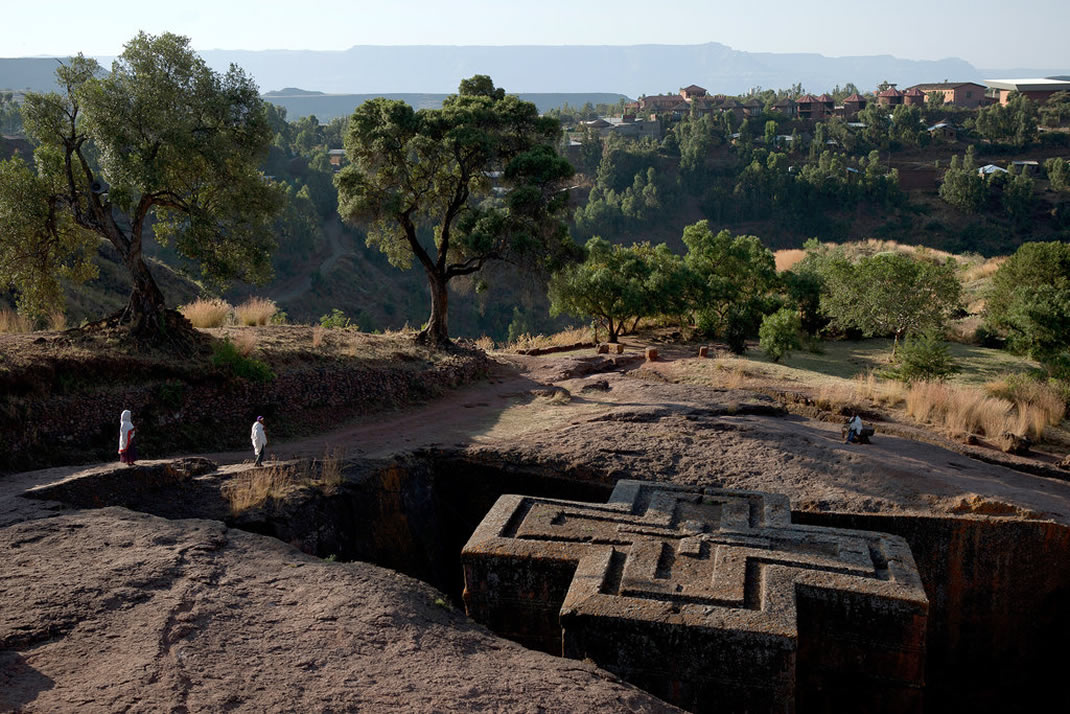
Hundreds of miles to the south and east of Axum with daily Ethiopian Airlines flight from Addis Ababa, is another ancient settlement, Lalibela, which is also famous for its architecture. Lalibela is a city carved from legend-a medieval settlement in the Lasta area of Wollo that is the site of the 11 remarkable rock-hewn monolithic churches, believed to have been built by King Lalibela in the late 12th or early 13th century. These notable structures are curved inside and outside the solid rock, and are considered among the wonders of the world. Each building is architecturally unique, and several of them are decorated with fascinating rock paintings. The unadulterated biblical atmosphere and vivid local of the Timket celebrations provide an ideal opportunity to see Lalibela as a sacred centre whose roots go back to man’s early years.
Harar

No journey along Ethiopia’s fable historic route would be complete without a visit to the medieval walled city of Harar, which stand amid green mountains on the east wall of the Great Rift Valley. Harar’s heritage is almost entirely Muslim and Oriental. Harar has probably always had a great deal more in common with the Horn’s coastal culture than with the life of the highlands –and it retains to this day a certain redolence of the Orient. The most dominant features, apart from its strong encircling walls, are its rich and exciting market place-probably the most colorful in Ethiopia. With its 90 mosques and shrines, Harar is considered to be the fourth-most sacred centre of the Islamic world. Its Islamic character is best expressed in the Grand Mosque (AL Jami), which dominate the town.
Rightly renowned for its intricately worked filigree jewellery of silver, gold and amber, Harar,s Megalo Gudo market is also a centre for beautiful baskets of woven grass, decorative wall mats and bright shawls, as well as all the fruits, vegetable, spices, and grains of the province . Herar’s five gates –the only means to enter or leave the city centre –have been strongly guarded over the years. The fully restored Rimbaud house is well worth a visit.
Ethiopia’s Nature and Wildlife

Of all the Great Rift Valle lakes know, 7 are in Ethiopia. Some are alkaline brown, yet surprisingly good for swimming; some are tropical in setting; some are bordered or fed by hot mineral springs; some pay host to large flocks of flamingos, pelicans, cormorants, herons, storks and ibises; with 831 recorded bird species, Ethiopia is a bird-watchers paradise.
Ethiopia Lake Tana is the source of the Blue Nile. The lake is dotted with island monasteries, which house many treasures of medieval art. Only 30 kilometer from the lake, the river explodes over Tis Isat falls (meaning ‘smoke on fire’)-a sight that inspired wonder from the 18th –century explorer, James Bruce. Before the Blue Nile joins the White Nile, which flow north from Lake Victoria, it runs from 800 kilometer through one of the world deepest and most dramatic gorges.
Ethiopia’s mountain rise up to a height of over 4000 meters, with mount Batu, the second highest peak in Ethiopia, rising to 4,307 meters. The national park enable the visitors to enjoy the country scenery and its wildlife, conserve in natural habitats, and offer opportunities for travel adventure unparalleled in Africa. Awash National Park is the oldest and most developed wildlife reserve in Ethiopia. Featuring the 1,800-metre fantalle Volcano, numerous mineral hot springs and extraordinary volcanic formations, these natural treasures is bordered to the south by the Awash River and lies 225 kilometer east of the capital, Addis Ababa.

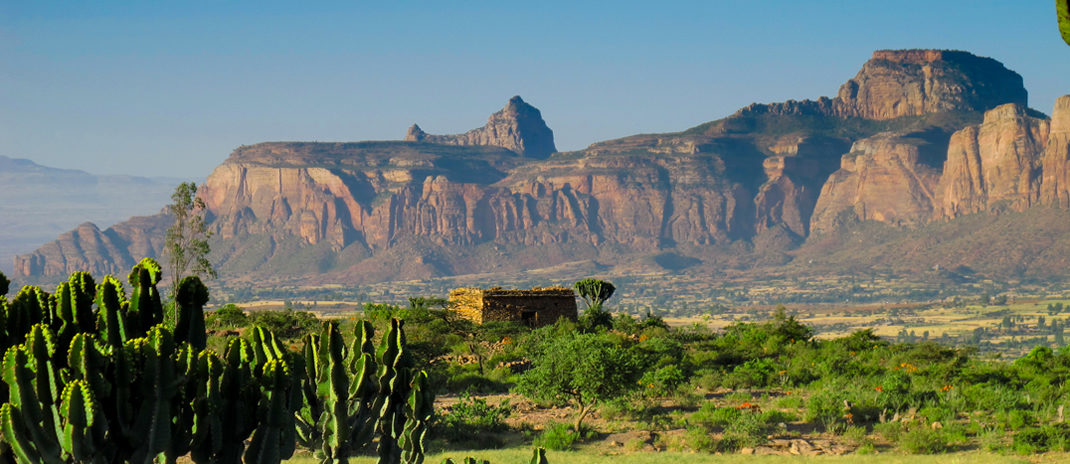


Leave a Reply